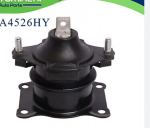I expect to get mixed replies on this one, but I've been suffering from Engineer Brain lately and I want to take a swipe at reducing the chassis vibration of an 802a.
Background: I've own an 802a since 2018 and an 803a since 2023. I really like how smooth the 803a is, but most situations call for the 802a. I came across a parts bucket of 802a and got it running, but the vibration is the worst I've seen, yet it still feels somewhat normal for these machines. My concern is the longterm damage to wires, gauges, relays, etc.
This has led to a nagging desire to re-analyze the approach taken by the OEM engineers to isolate the vibration-prone two-cylinder engine and see if there is room for improvement. I've researched the general approach to driven vibration isolation and will start by analyzing the natural frequency of the DN2M's isolators and compare that to the driven frequency, calculating the transmissibility of the system. From there, make a judgement call on whether there is room for improvement by modifying the isolator rate or damping coefficient. If meaningful gains could be realized, I will experiment. If not, I will explore the level-of-effort involved in adding an active balancing element to the engine.
Feel free to follow along, comment, or ridicule. This felt like a fun learning exercise.
Background: I've own an 802a since 2018 and an 803a since 2023. I really like how smooth the 803a is, but most situations call for the 802a. I came across a parts bucket of 802a and got it running, but the vibration is the worst I've seen, yet it still feels somewhat normal for these machines. My concern is the longterm damage to wires, gauges, relays, etc.
This has led to a nagging desire to re-analyze the approach taken by the OEM engineers to isolate the vibration-prone two-cylinder engine and see if there is room for improvement. I've researched the general approach to driven vibration isolation and will start by analyzing the natural frequency of the DN2M's isolators and compare that to the driven frequency, calculating the transmissibility of the system. From there, make a judgement call on whether there is room for improvement by modifying the isolator rate or damping coefficient. If meaningful gains could be realized, I will experiment. If not, I will explore the level-of-effort involved in adding an active balancing element to the engine.
Feel free to follow along, comment, or ridicule. This felt like a fun learning exercise.








